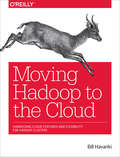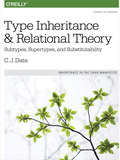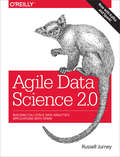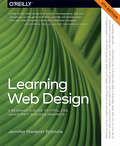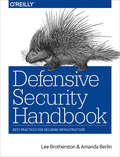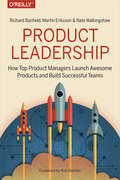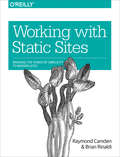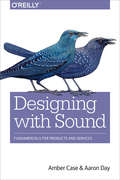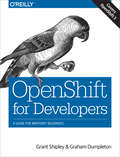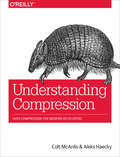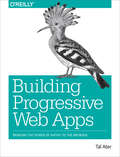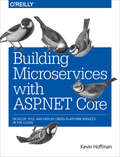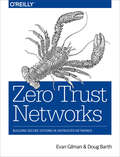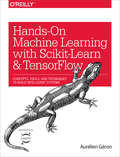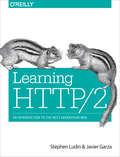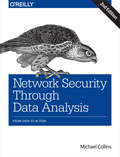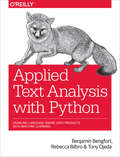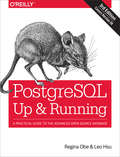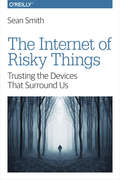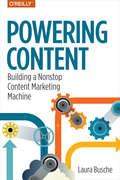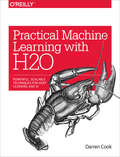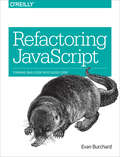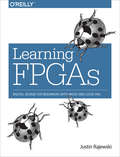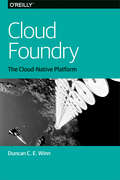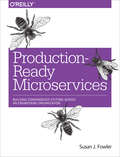- Table View
- List View
Moving Hadoop to the Cloud: Harnessing Cloud Features and Flexibility for Hadoop Clusters
by Bill HavankiUntil recently, Hadoop deployments existed on hardware owned and run by organizations. Now, of course, you can acquire the computing resources and network connectivity to run Hadoop clusters in the cloud. But there’s a lot more to deploying Hadoop to the public cloud than simply renting machines.This hands-on guide shows developers and systems administrators familiar with Hadoop how to install, use, and manage cloud-born clusters efficiently. You’ll learn how to architect clusters that work with cloud-provider features—not just to avoid pitfalls, but also to take full advantage of these services. You’ll also compare the Amazon, Google, and Microsoft clouds, and learn how to set up clusters in each of them.Learn how Hadoop clusters run in the cloud, the problems they can help you solve, and their potential drawbacksExamine the common concepts of cloud providers, including compute capabilities, networking and security, and storageBuild a functional Hadoop cluster on cloud infrastructure, and learn what the major providers requireExplore use cases for high availability, relational data with Hive, and complex analytics with SparkGet patterns and practices for running cloud clusters, from designing for price and security to dealing with maintenance
Type Inheritance and Relational Theory: Subtypes, Supertypes, and Substitutability
by C. J. DateType inheritance is that phenomenon according to which we can say, for example, that every square is also a rectangle, and so properties that apply to rectangles in general apply to squares in particular. In other words, squares are a subtype of rectangles, and rectangles are a supertype of squares. Recognizing and acting upon such subtype / supertype relationships provides numerous benefits: Certainly it can help in data modeling, and it can also provide for code reuse in applications. For these reasons, many languages, including the standard database language SQL, have long supported such relationships. However, there doesn't seem to be any consensus in the community at large on a formal, rigorous, and abstract model of inheritance. This book proposes such a model, one that enjoys several advantages over other approaches, not the least of which it is that it's fully compatible with the well known relational model of data.Topics the model covers include:Both single and multiple inheritanceScalar, tuple, and relation inheritanceType lattices and union and intersection typesPolymorphism and substitutabilityCompile time and run time bindingAll of these topics are described in detail in the book, with numerous illustrative examples, exercises, and answers. The book also discusses several alternative approaches. In particular, it includes a detailed discussion and analysis of inheritance as supported in the SQL standard.
Agile Data Science 2.0: Building Full-Stack Data Analytics Applications with Spark (Oreilly And Associate Ser.)
by Russell JurneyData science teams looking to turn research into useful analytics applications require not only the right tools, but also the right approach if they’re to succeed. With the revised second edition of this hands-on guide, up-and-coming data scientists will learn how to use the Agile Data Science development methodology to build data applications with Python, Apache Spark, Kafka, and other tools.Author Russell Jurney demonstrates how to compose a data platform for building, deploying, and refining analytics applications with Apache Kafka, MongoDB, ElasticSearch, d3.js, scikit-learn, and Apache Airflow. You’ll learn an iterative approach that lets you quickly change the kind of analysis you’re doing, depending on what the data is telling you. Publish data science work as a web application, and affect meaningful change in your organization.Build value from your data in a series of agile sprints, using the data-value pyramidExtract features for statistical models from a single datasetVisualize data with charts, and expose different aspects through interactive reportsUse historical data to predict the future via classification and regressionTranslate predictions into actionsGet feedback from users after each sprint to keep your project on track
Learning Web Design: A Beginner's Guide to HTML, CSS, JavaScript, and Web Graphics
by Jennifer RobbinsDo you want to build web pages but have no prior experience? This friendly guide is the perfect place to start. You’ll begin at square one, learning how the web and web pages work, and then steadily build from there. By the end of the book, you’ll have the skills to create a simple site with multicolumn pages that adapt for mobile devices.Each chapter provides exercises to help you learn various techniques and short quizzes to make sure you understand key concepts.This thoroughly revised edition is ideal for students and professionals of all backgrounds and skill levels. It is simple and clear enough for beginners, yet thorough enough to be a useful reference for experienced developers keeping their skills up to date.Build HTML pages with text, links, images, tables, and formsUse style sheets (CSS) for colors, backgrounds, formatting text, page layout, and even simple animation effectsLearn how JavaScript works and why the language is so important in web designCreate and optimize web images so they’ll download as quickly as possibleNEW! Use CSS Flexbox and Grid for sophisticated and flexible page layoutNEW! Learn the ins and outs of Responsive Web Design to make web pages look great on all devicesNEW! Become familiar with the command line, Git, and other tools in the modern web developer’s toolkitNEW! Get to know the super-powers of SVG graphics
Defensive Security Handbook: Best Practices for Securing Infrastructure
by Lee Brotherston Amanda BerlinDespite the increase of high-profile hacks, record-breaking data leaks, and ransomware attacks, many organizations don’t have the budget to establish or outsource an information security (InfoSec) program, forcing them to learn on the job. For companies obliged to improvise, this pragmatic guide provides a security-101 handbook with steps, tools, processes, and ideas to help you drive maximum-security improvement at little or no cost.Each chapter in this book provides step-by-step instructions for dealing with a specific issue, including breaches and disasters, compliance, network infrastructure and password management, vulnerability scanning, and penetration testing, among others. Network engineers, system administrators, and security professionals will learn tools and techniques to help improve security in sensible, manageable chunks.Learn fundamentals of starting or redesigning an InfoSec programCreate a base set of policies, standards, and proceduresPlan and design incident response, disaster recovery, compliance, and physical securityBolster Microsoft and Unix systems, network infrastructure, and password managementUse segmentation practices and designs to compartmentalize your networkExplore automated process and tools for vulnerability managementSecurely develop code to reduce exploitable errorsUnderstand basic penetration testing concepts through purple teamingDelve into IDS, IPS, SOC, logging, and monitoring
Product Leadership: How Top Product Managers Launch Awesome Products and Build Successful Teams
by Martin Eriksson Nate Walkingshaw Richard BanfieldIn today’s lightning-fast technology world, good product management is critical to maintaining a competitive advantage. Yet, managing human beings and navigating complex product roadmaps is no easy task, and it’s rare to find a product leader who can steward a digital product from concept to launch without a couple of major hiccups. Why do some product leaders succeed while others don’t?This insightful book presents interviews with nearly 100 leading product managers from all over the world. Authors Richard Banfield, Martin Eriksson, and Nate Walkingshaw draw on decades of experience in product design and development to capture the approaches, styles, insights, and techniques of successful product managers. If you want to understand what drives good product leaders, this book is an irreplaceable resource.In three parts, Product Leadership helps you explore:Themes and patterns of successful teams and their leaders, and ways to attain those characteristicsBest approaches for guiding your product team through the startup, emerging, and enterprise stages of a company’s evolutionStrategies and tactics for working with customers, agencies, partners, and external stakeholders
Working with Static Sites: Bringing the Power of Simplicity to Modern Sites
by Raymond Camden Brian RinaldiJust like vinyl LPs, static sites are making a comeback, evidenced by the wide array of static-site generators now available. This practical book shows you hands-on how to build these simple sites for blogs and other use cases, and how to make them more powerful. In the process, you’ll work with some of today’s more mature and popular static-site generators.Authors Raymond Camden and Brian Rinaldi explain the advantages of using static-site generators for building fast and secure sites. Web and frontend designers and developers will also explore methods for adding dynamic elements and for migrating an existing CMS to a static site.Build a basic four-page static site with the Harp generatorCreate a simple blog with JekyllDevelop a documentation site with Hugo by generating site files and creating the layoutAdd dynamic elements, such as forms, comments, and searchIntegrate a CMS with tools such as CloudCannon and Netlify CMSUse one of several options to deploy your static filesLearn methods for moving an existing CMS to a static site
Designing with Sound: Fundamentals for Products and Services
by Amber Case Aaron DaySound can profoundly impact how people interact with your product. Well-designed sounds can be exceptionally effective in conveying subtle distinctions, emotion, urgency, and information without adding visual clutter. In this practical guide, Amber Case and Aaron Day explain why sound design is critical to the success of products, environments, and experiences.Just as visual designers have a set of benchmarks and a design language to guide their work, this book provides a toolkit for the auditory experience, improving collaboration for a wide variety of stakeholders, from product developers to composers, user experience designers to architects. You’ll learn a complete process for designing, prototyping, and testing sound.In two parts, this guide includes:Past, present, and upcoming advances in sound designPrinciples for designing quieter productsGuidelines for intelligently adding and removing sound in interactionsWhen to use voice interfaces, how to consider personalities, and how to build a knowledge map of queriesWorking with brands to create unique and effective audio logos that will speak to your customersAdding information using sonification and generative audio
OpenShift for Developers: A Guide for Impatient Beginners
by Graham Dumpleton Grant ShipleyKeen to build web applications for the cloud? Get a quick hands-on introduction to OpenShift, the open source Platform as a Service (PaaS) offering from Red Hat. With this practical guide, you’ll learn the steps necessary to build, deploy, and host a complete real-world application on OpenShift without having to slog through long, detailed explanations of the technologies involved. OpenShift enables you to use Docker application containers and the Kubernetes cluster manager to automate the way you create, ship, and run applications. Through the course of the book, you’ll learn how to use OpenShift and the Wildfly application server to build and then immediately deploy a Java application online. Learn about OpenShift’s core technology, including Docker-based containers and Kubernetes; Use a virtual machine with OpenShift installed and configured on your local environment; Create and deploy your first application on the OpenShift platform; Add language runtime dependencies and connect to a database; Trigger an automatic rebuild and redeployment when you push changes to the repository; Get a working environment up in minutes with application templates; Use commands to check and debug your application; Create and build Docker-based images for your application.
Understanding Compression: Data Compression for Modern Developers
by Aleks Haecky Colt McanlisIf you want to attract and retain users in the booming mobile services market, you need a quick-loading app that won’t churn through their data plans. The key is to compress multimedia and other data into smaller files, but finding the right method is tricky. This witty book helps you understand how data compression algorithms work—in theory and practice—so you can choose the best solution among all the available compression tools. With tables, diagrams, games, and as little math as possible, authors Colt McAnlis and Aleks Haecky neatly explain the fundamentals. Learn how compressed files are better, cheaper, and faster to distribute and consume, and how they’ll give you a competitive edge. Learn why compression has become crucial as data production continues to skyrocket; Know your data, circumstances, and algorithm options when choosing compression tools; Explore variable-length codes, statistical compression, arithmetic numerical coding, dictionary encodings, and context modeling; Examine tradeoffs between file size and quality when choosing image compressors; Learn ways to compress client- and server-generated data objects; Meet the inventors and visionaries who created data compression algorithms.
Building Progressive Web Apps: Bringing the Power of Native to the Browser
by Tal AterMove over native apps. New progressive web apps have capabilities that will soon make you obsolete. With this hands-on guide, web developers and business execs will learn how—and why—to develop web apps that take advantage of features that have so far been exclusive to native apps. Features that include fast load times, push notifications, offline access, homescreen shortcuts, and an entirely app-like experience.By leveraging the latest browser APIs, progressive web apps combine all of the benefits of native apps, while avoiding their issues. Throughout the book, author Tal Ater shows you how to improve a simple website for the fictional Gotham Imperial Hotel into a modern progressive web app. Plus:Understand how service workers work, and use them to create sites that launch in an instant, regardless of the user’s internet connectionCreate full-screen web apps that launch from the phone's homescreen just like native appsRe-engage users with push notifications, even days after they have left your siteEmbrace offline-first and build web apps that gracefully handle loss of connectivityExplore new UX opportunities and challenges presented by progressive web apps
Building Microservices with ASP.NET Core: Develop, Test, and Deploy Cross-Platform Services in the Cloud
by Kevin HoffmanAt a time when nearly every vertical, regardless of domain, seems to need software running in the cloud to make money, microservices provide the agility and drastically reduced time to market you require. This hands-on guide shows you how to create, test, compile, and deploy microservices, using the ASP.NET Core free and open-source framework. Along the way, you’ll pick up good, practical habits for building powerful and robust services.Building microservices isn’t about learning a specific framework or programming language; it’s about building applications that thrive in elastically scaling environments that don't have host affinity, and that can start and stop at a moment’s notice. This practical book guides you through the process.Learn test-driven and API-first development conceptsCommunicate with other services by creating and consuming backing services such as databases and queuesBuild a microservice that depends on an external data sourceLearn about event sourcing, the event-centric approach to persistenceUse ASP.NET Core to build web applications designed to thrive in the cloudBuild a service that consumes, or is consumed by, other servicesCreate services and applications that accept external configurationExplore ways to secure ASP.NET Core microservices and applications
Zero Trust Networks: Building Secure Systems in Untrusted Networks
by Doug Barth Evan GilmanThe perimeter defenses guarding your network perhaps are not as secure as you think. Hosts behind the firewall have no defenses of their own, so when a host in the "trusted" zone is breached, access to your data center is not far behind. That’s an all-too-familiar scenario today. With this practical book, you’ll learn the principles behind zero trust architecture, along with details necessary to implement it.The Zero Trust Model treats all hosts as if they’re internet-facing, and considers the entire network to be compromised and hostile. By taking this approach, you’ll focus on building strong authentication, authorization, and encryption throughout, while providing compartmentalized access and better operational agility.Understand how perimeter-based defenses have evolved to become the broken model we use todayExplore two case studies of zero trust in production networks on the client side (Google) and on the server side (PagerDuty)Get example configuration for open source tools that you can use to build a zero trust networkLearn how to migrate from a perimeter-based network to a zero trust network in production
Hands-On Machine Learning with Scikit-Learn and TensorFlow: Concepts, Tools, and Techniques to Build Intelligent Systems
by Aurélien GéronGraphics in this book are printed in black and white.Through a series of recent breakthroughs, deep learning has boosted the entire field of machine learning. Now, even programmers who know close to nothing about this technology can use simple, efficient tools to implement programs capable of learning from data. This practical book shows you how.By using concrete examples, minimal theory, and two production-ready Python frameworks—scikit-learn and TensorFlow—author Aurélien Géron helps you gain an intuitive understanding of the concepts and tools for building intelligent systems. You’ll learn a range of techniques, starting with simple linear regression and progressing to deep neural networks. With exercises in each chapter to help you apply what you’ve learned, all you need is programming experience to get started. Explore the machine learning landscape, particularly neural nets; Use scikit-learn to track an example machine-learning project end-to-end; Explore several training models, including support vector machines, decision trees, random forests, and ensemble methods; Use the Tensor; Flow library to build and train neural nets; Dive into neural net architectures, including convolutional nets, recurrent nets, and deep reinforcement learning; Learn techniques for training and scaling deep neural nets; and apply practical code examples without acquiring excessive machine learning theory or algorithm details.
Learning HTTP/2: A Practical Guide for Beginners
by Javier Garza Stephen LudinWhat can your organization gain by adopting HTTP/2? How about faster, simpler, and more robust websites and applications? This practical guide demonstrates how the latest version of the Hypertext Transfer Protocol can dramatically improve website and application performance. You’ll take a deep dive into HTTP/2 details, and learn how this updated protocol is changing the web landscape.HTTP/1.1 has been the primary means of communicating data across the web for the past 20 years, but the level of interaction today has gone well beyond what people envisioned in 1997. With this book, authors Stephen Ludin and Javier Garza show you how HTTP/2 will help speed the execution of modern sites and applications.With this book, you’ll explore:Performance challenges that led to the HTTP upgradeHTTP/2 in a nutshell, including benefits and transition methodsExisting best practices and hacks to improve web performanceHTTP/2 support for browsers, servers, proxies, and content delivery networksHow the performance of sites using HTTP/2 compares to their HTTP/1.1 experienceHTTP/2’s effect on specific issues such as latency, packet loss, and Time to First Byte (TTFB)HTTP/2’s effect on specific issues such as latency, packet loss, and Time to First Byte (TTFB)
Network Security Through Data Analysis: From Data to Action
by Michael CollinsTraditional intrusion detection and logfile analysis are no longer enough to protect today’s complex networks. In the updated second edition of this practical guide, security researcher Michael Collins shows InfoSec personnel the latest techniques and tools for collecting and analyzing network traffic datasets. You’ll understand how your network is used, and what actions are necessary to harden and defend the systems within it.In three sections, this book examines the process of collecting and organizing data, various tools for analysis, and several different analytic scenarios and techniques. New chapters focus on active monitoring and traffic manipulation, insider threat detection, data mining, regression and machine learning, and other topics.You’ll learn how to:Use sensors to collect network, service, host, and active domain dataWork with the SiLK toolset, Python, and other tools and techniques for manipulating data you collectDetect unusual phenomena through exploratory data analysis (EDA), using visualization and mathematical techniquesAnalyze text data, traffic behavior, and communications mistakesIdentify significant structures in your network with graph analysisExamine insider threat data and acquire threat intelligenceMap your network and identify significant hosts within itWork with operations to develop defenses and analysis techniques
Applied Text Analysis with Python: Enabling Language-Aware Data Products with Machine Learning
by Benjamin Bengfort Rebecca Bilbro Tony OjedaFrom news and speeches to informal chatter on social media, natural language is one of the richest and most underutilized sources of data. Not only does it come in a constant stream, always changing and adapting in context; it also contains information that is not conveyed by traditional data sources. The key to unlocking natural language is through the creative application of text analytics. This practical book presents a data scientist’s approach to building language-aware products with applied machine learning.You’ll learn robust, repeatable, and scalable techniques for text analysis with Python, including contextual and linguistic feature engineering, vectorization, classification, topic modeling, entity resolution, graph analysis, and visual steering. By the end of the book, you’ll be equipped with practical methods to solve any number of complex real-world problems.Preprocess and vectorize text into high-dimensional feature representationsPerform document classification and topic modelingSteer the model selection process with visual diagnosticsExtract key phrases, named entities, and graph structures to reason about data in textBuild a dialog framework to enable chatbots and language-driven interactionUse Spark to scale processing power and neural networks to scale model complexity
PostgreSQL: A Practical Guide to the Advanced Open Source Database
by Regina O. Obe Leo S. HsuThinking of migrating to PostgreSQL? This clear, fast-paced introduction helps you understand and use this open source database system. Not only will you learn about the enterprise class features in versions 9.5 to 10, you’ll also discover that PostgeSQL is more than a database system—it’s an impressive application platform as well.With examples throughout, this book shows you how to achieve tasks that are difficult or impossible in other databases. This third edition covers new features, such as ANSI-SQL constructs found only in proprietary databases until now: foreign data wrapper (FDW) enhancements; new full text functions and operator syntax introduced in version 9.6; XML constructs new in version 10; query parallelization features introduced in 9.6 and enhanced in 10; built-in logical replication introduced in Version 10.e.If you’re a current PostgreSQL user, you’ll pick up gems you may have missed before.Learn basic administration tasks such as role management, database creation, backup, and restoreApply the psql command-line utility and the pgAdmin graphical administration toolExplore PostgreSQL tables, constraints, and indexesLearn powerful SQL constructs not generally found in other databasesUse several different languages to write database functionsTune your queries to run as fast as your hardware will allowQuery external and variegated data sources with foreign data wrappersLearn how to use built-in replication to replicate data
The Internet of Risky Things: Trusting the Devices That Surround Us
by Sean SmithBy 2020, the Internet of Things (IoT) will consist of millions of computational devices intimately connected to real-world aspects of human life. In this insightful book, Professor Sean Smith, who worked in information security long before the web appeared, explains that if we build the IoT the way we built the current internet and other information technology initiatives, we’re headed for trouble.With a focus on concrete solutions, The Internet of Risky Things explains how we can avoid simple flaws that have plagued several dramatic IT advances in recent decades. Developers, engineers, industrial designers, makers, and researchers will explore "design patterns of insecurities" and learn what’s required to route around or fix them in the nascent IoT.Examine bugs that plague large-scale systems, including integer overflow, race conditions, and memory corruptionLook at successful and disastrous examples of previous quantum leaps in health IT, the smart grid, and autonomous vehiclesExplore patterns in coding, authentication, and cryptography that led to insecurityLearn how blunders that led to spectacular IT disasters could have been avoided
Powering Content: Building a Nonstop Content Marketing Machine
by Laura BuscheYour new product is ready to launch and you’re itching to tell potential customers all about it. But how do you make your message stand out above all the noise and marketing clutter? Take the guesswork out of content management with this hands-on guide. You’ll learn how to produce and manage powerful content pieces that speak directly to customers and compel them to respond.Author Laura Busche walks you through content strategies and tactics drawn from business, design, and psychology insights. Packed with examples and exercises, this book teaches you how to tell your story with engaging copy, potent images, and striking design—all carefully orchestrated through well-oiled production management. Solopreneurs, startups, marketing managers, and execs will learn 10 Essential Steps to Content Success, with deep dives into:Content strategy: understand your audience, choose and prioritize channels, and find your brand’s core themes, voice, and toneContent creation: craft an engaging experience with content formats and copywriting formulas and templatesContent management: organize, delegate, and supervise tasks; optimize the content production process to reuse successful patterns
Practical Machine Learning with H2O: Powerful, Scalable Techniques for Deep Learning and AI
by Darren Cookthis is a test paragraph.this is the second test paragraph.
Refactoring JavaScript: Turning Bad Code Into Good Code
by Evan BurchardHow often do you hear people say things like this? "Our JavaScript is a mess, but we’re thinking about using [framework of the month]."Like it or not, JavaScript is not going away. No matter what framework or ”compiles-to-js” language or library you use, bugs and performance concerns will always be an issue if the underlying quality of your JavaScript is poor. Rewrites, including porting to the framework of the month, are terribly expensive and unpredictable. The bugs won’t magically go away, and can happily reproduce themselves in a new context. To complicate things further, features will get dropped, at least temporarily.The other popular method of fixing your JS is playing “JavaScript Jenga,” where each developer slowly and carefully takes their best guess at how the out-of-control system can be altered to allow for new features, hoping that this doesn’t bring the whole stack of blocks down. This book provides clear guidance on how best to avoid these pathological approaches to writing JavaScript:Recognize you have a problem with your JavaScript quality.Forgive the code you have now, and the developers who made it.Learn repeatable, memorable, and time-saving refactoring techniques.Apply these techniques as you work, fixing things along the way.Internalize these techniques, and avoid writing as much problematic code to begin with.Bad code doesn’t have to stay that way. And making it better doesn’t have to be intimidating or unreasonably expensive.
Learning FPGAs: Digital Design for Beginners with Mojo and Lucid HDL
by Justin RajewskiLearn how to design digital circuits with FPGAs (field-programmable gate arrays), the devices that reconfigure themselves to become the very hardware circuits you set out to program. With this practical guide, author Justin Rajewski shows you hands-on how to create FPGA projects, whether you’re a programmer, engineer, product designer, or maker. You’ll quickly go from the basics to designing your own processor.Designing digital circuits used to be a long and costly endeavor that only big companies could pursue. FPGAs make the process much easier, and now they’re affordable enough even for hobbyists. If you’re familiar with electricity and basic electrical components, this book starts simply and progresses through increasingly complex projects.Set up your environment by installing Xilinx ISE and the author’s Mojo IDELearn how hardware designs are broken into modules, comparable to functions in a software programCreate digital hardware designs and learn the basics on how they’ll be implemented by the FPGABuild your projects with Lucid, a beginner-friendly hardware description language, based on Verilog, with syntax similar to C/C++ and Java
Cloud Foundry: The Cloud-Native Platform
by Duncan C. E. WinnWhat exactly is a cloud-native platform? It's certainly a hot topic in IT, as enterprises today assess this option for developing and delivering software quickly and repeatedly. This O'Reilly report explains the capabilities of cloud-native platforms and examines the fundamental changes enterprises need to make in process, organization, and culture if they're to take real advantage of this approach.Author Duncan Winn focuses on the open source platform Cloud Foundry, one of the more prominent cloud-native providers. You'll learn how cloud-native applications are designed to be "infrastructure unaware" so they can thrive and move at will in the highly distributed and constantly evolving cloud environment.With this report, you'll explore:Technical driving forces that are rapidly changing the way organizations develop and deliver software todayHow key concepts underpinning the Cloud Foundry platform leverage each of the technical forces discussedHow cloud-native platforms remove the requirement to perform undifferentiated heavy lifting, such as provisioning VMs, middleware, and databasesWhy cloud-native platforms enable fast feedback loops as you move from agile development to agile deploymentRecommended changes and practical considerations for organizations that want to build cloud-native applications
Production-Ready Microservices: Building Standardized Systems Across an Engineering Organization
by Susan J. FowlerOne of the biggest challenges for organizations that have adopted microservice architecture is the lack of architectural, operational, and organizational standardization. After splitting a monolithic application or building a microservice ecosystem from scratch, many engineers are left wondering what's next. In this practical book, author Susan Fowler presents a set of microservice standards in depth, drawing from her experience standardizing over a thousand microservices at Uber. You'll learn how to design microservices that are stable, reliable, scalable, fault tolerant, performant, monitored, documented, and prepared for any catastrophe.Explore production-readiness standards, including:Stability and Reliability: develop, deploy, introduce, and deprecate microservices; protect against dependency failuresScalability and Performance: learn essential components for achieving greater microservice efficiencyFault Tolerance and Catastrophe Preparedness: ensure availability by actively pushing microservices to fail in real timeMonitoring: learn how to monitor, log, and display key metrics; establish alerting and on-call proceduresDocumentation and Understanding: mitigate tradeoffs that come with microservice adoption, including organizational sprawl and technical debt
